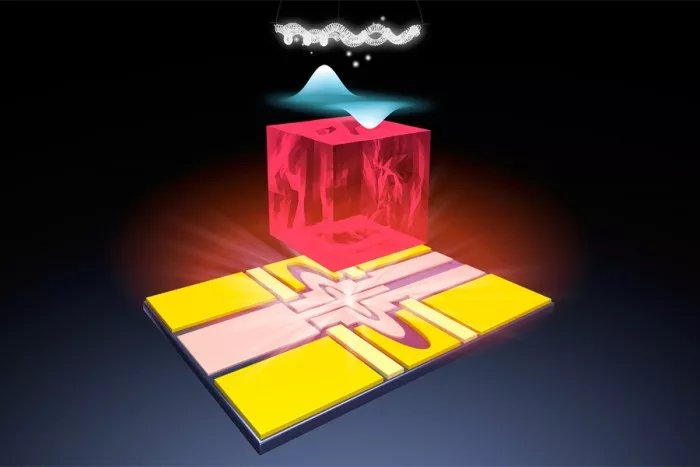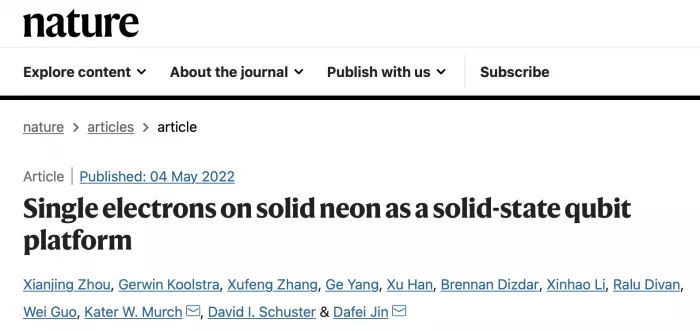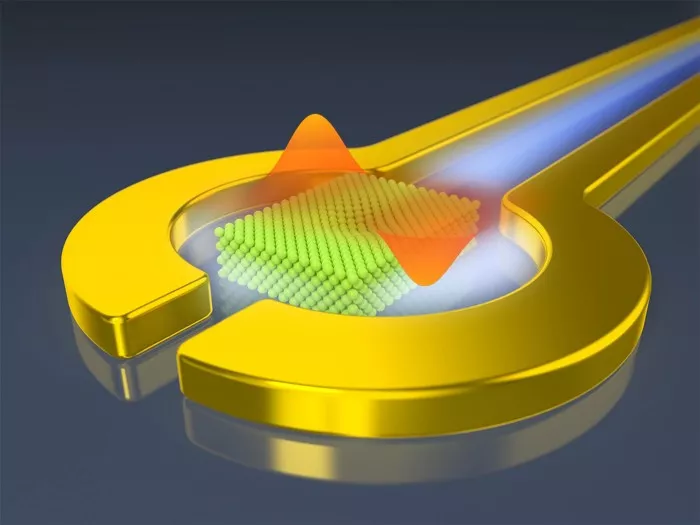Recently, the Argonne National Laboratory of the U.S. Department of energy (DOE) announced that its team has developed a new quantum bit platform based on solid-state neon. New quantum bit platform: electrons from the top heated filament fall onto solid neon (red block), and a single electron (blue indicates wave function) is captured and manipulated by the bottom superconducting quantum circuit chip. The picture comes from Argonne National Laboratory. At present, scientists all over the world are competing to develop quantum computers.

As an operation unit of quantum computing, qubits can represent the superposition of 0 and 1 states. In the future, quantum computers can solve specific complex problems that cannot be solved by any classical supercomputer.
This time, the research team led by Argonne National Laboratory cooperated with Wei Guo, an associate professor of mechanical engineering at FAMU-FSU School of Engineering (the Joint School of engineering of Florida a & M University and Florida State University), to build a new qubit platform and demonstrate the potential of developing quantum computers. Relevant achievements were recently published in nature.

The picture is from nature. Participants in the previous study also included scientists from the University of Chicago, Washington University in St. Louis, Lawrence Berkeley National Laboratory (LBNL) and MIT.
"Through this research, we believe that an important breakthrough has been made, which will make great progress in the manufacture of quantum bits and help realize the potential of this technology." Said Wei Guo, co-author of the paper.
By freezing neon gas into a solid at extremely low temperatures, the aforementioned team sprayed electrons from the heated filament in the bulb onto the solid and captured a single electron to create a new type of quantum bit. When neon cools to about minus 248.6 degrees Celsius and the pressure exceeds 0.42 atmospheres, it freezes into a solid.

Although there are many types of qubits, the team chose the simplest one, that is, a single electron. Heating a simple filament in a daily light bulb can easily emit infinite electrons.
An important characteristic of qubit is that it can maintain the state of 0 or 1 for a long time, which is called "coherence time". However, the coherence time is limited, which is determined by the way qubits interact with the environment. The defects in quantum bit system will greatly reduce the coherence time.
For the above reasons, the team chose to capture electrons on the surface of ultrapure solid neon in vacuum. Neon is one of the only six inert elements at present, which means that it will not react with other elements.
Previous studies used liquid helium as the medium to preserve electrons. Although liquid helium is easy to make, solid neon is a material with few defects and will not vibrate like liquid helium. Vibration can easily disturb the electronic state and affect the performance of qubits.
"Due to this inertia, solid neon can be used as the purest solid in vacuum to carry and protect any qubit from interference." Dafei Jin, a scientist at Argonne National Laboratory and chief researcher of the project, said.
By using a chip level superconducting resonator, the electrodes in the microchip can keep the electrons trapped in solid neon in place for more than two months. With the help of the microwave emitted by the superconducting microwave resonator, the team manipulates the captured electrons so that they can read and store information from qubits, which can be applied to future quantum computers.

Superconducting microwave resonator (gold) can use microwave (light blue beam) to help control an isolated electron (orange wave function), which is trapped on a solid neon (green). The picture is from Argonne National Laboratory. After establishing the above-mentioned qubit platform, the team used microwave photons to operate the captured electron in real time and described its quantum characteristics. Experimental results show that solid neon provides a stable environment for electrons and has very low electronic noise interference. At the same time, the coherence time of the qubit in the quantum state is more competitive than other qubits.
"Based on this platform, we have realized the strong coupling between a single electron in a near vacuum environment and a single microwave photon in a vibrator for the first time," said Xianjing Zhou, a postdoctoral fellow at Argonne National Laboratory and the first author of the paper. "This opens up the possibility of using microwave photons to control each electronic qubit and connect multiple qubits in a quantum processor."
Scientists believe that practical qubits need to have three key qualities: first, they can show consistency for a long time, that is, they can maintain the superposition state for a long time, ideally more than one second; 2、 It can quickly transition from one state to another to help perform operations quickly, ideally about one billionth of a second; 3、 Through a quantum mechanical phenomenon called entanglement, it can be expanded proportionally and connected with many other quantum bits to realize parallel work.
The above experiments show that after optimization, the new qubit can maintain the superposition state of 220 nanoseconds, and it only takes a few nanoseconds to change the state (1 nanosecond is one billionth of a second), which is better than the charge based qubit studied for 20 years.
Researchers believe that by developing qubits based on electron spin rather than charge, it is more likely to develop qubits with coherence time of more than one second. At the same time, the device is relatively simple and easier to manufacture at low cost.
At present, researchers do not know how scalable the new system is. "This is still a common problem for all qubit platforms," Dafei Jin said. "It's not easy to achieve hundreds of qubits in the short term."
In the future, the team also plans to entangle two kinds of qubits based on electron spin and charge, so as to achieve the goal of manufacturing dozens of qubits on the same chip.